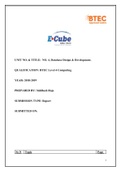Exam (elaborations)
Database
- Module
- BTECH
- Institution
- PEARSON (PEARSON)
Design a relational database system using appropriate design tools and techniques, containing at least four interrelated tables, with clear statements of user and systems requirements.
[Show more]



